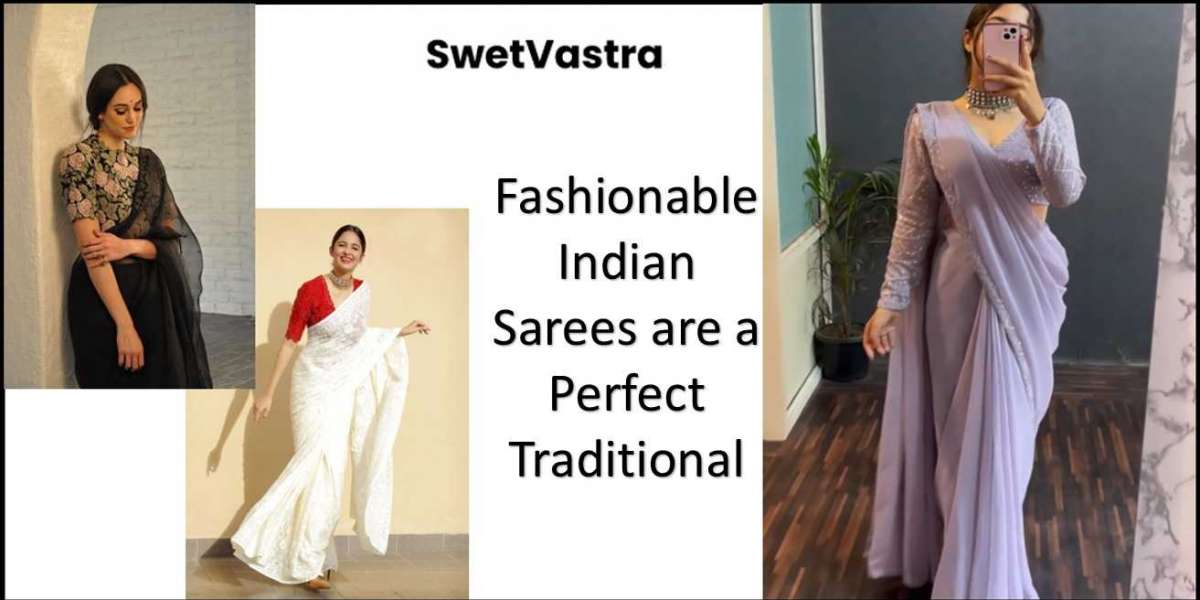Fashionable Indian Sarees are a Perfect Traditional
Yes, Indian saree are a perfect traditional attire and have been an integral part of Indian culture for centuries. Sarees are made of various fabrics like silk, cotton, georgette, chiffon, and many more, which are adorned with different patterns, embroidery, and prints.
Indian sarees come in a range of colors and designs, reflecting the diverse cultures and traditions of India. They are versatile and can be worn for various occasions, from weddings to formal events, to everyday wear.
Apart from being a traditional attire, Indian sarees have also gained popularity in the fashion world. Many designers have created modern and innovative saree designs, combining traditional and contemporary styles, making them a fashionable choice for women worldwide.
Overall, Indian sarees are a perfect blend of traditional values and modern fashion, making them a timeless attire for any occasion.
Are you looking for the best clothing store in your life? So you visit swetvastra.com. In which you will find good quality clothes available and you will also get 50% discount.
Type of saree
There are many different types of sarees in India, each with its unique style, fabric, and embroidery. Here are some of the popular types of sarees:
Bandhani saree
Also known as tie-dye sarees, these sarees are made of lightweight fabric and are dyed in a pattern of small dots, creating a beautiful effect.
Bandhani sarees, also known as Bandhej sarees, are a type of tie-dye saree that is traditionally made in the western Indian states of Gujarat and Rajasthan. The word "Bandhani" comes from the Sanskrit word "bandhana," which means to tie.
Bandhani sarees are made by tying small portions of the fabric with thread before dyeing it. The tied portions resist the dye, creating a pattern of small dots in various colors. The dots can be arranged in a variety of patterns, from simple dots to intricate designs.
Bandhani sarees are typically made of lightweight fabrics like cotton or silk, and they come in a range of colors, from vibrant reds and pinks to subtle pastels. These sarees are often embellished with traditional motifs like paisleys, flowers, and geometric shapes.
Bandhani sarees are popular for both casual and formal occasions, and they are particularly popular during festivals like Navratri and Diwali. The sarees are often paired with traditional jewelry and accessories like bangles, earrings, and nose rings.
The process of making Bandhani sarees is highly skilled and time-consuming, involving several stages of tying, dyeing, and washing. The intricate designs and fine craftsmanship make Bandhani sarees a popular and sought-after choice for women in India and around the world.
Banarasi saree
Banarasi sarees are one of the most popular types of sarees in India, originating from Varanasi (also known as Banaras) in Uttar Pradesh. These sarees are made of fine silk and are known for their intricate gold or silver zari work and beautiful embroidery.
traditional bandhani sarees are woven with a combination of silk and zari threads, which are usually made of gold or silver. The motifs on these sarees are inspired by Mughal art and include intricate designs of flowers, leaves, and peacocks. The sarees are often bordered with heavy embroidery and have intricate pallus (the end portion of the saree that drapes over the shoulder).
Banarasi sarees are available in a range of colors, but the most popular colors are red and gold, which are considered auspicious in Indian culture. These sarees are often worn for weddings and other formal occasions.
The process of making Banarasi sarees is highly skilled and time-consuming, involving several stages of weaving, dyeing, and embroidery. The intricate designs and fine craftsmanship make Banarasi sarees highly valued and sought after.
Kanjeevaram saree
Kanjeevaram sarees, also known as Kanchipuram sarees, are traditional sarees from Kanchipuram, a town in Tamil Nadu, India. These sarees are made of pure mulberry silk and are known for their intricate and unique designs, rich colors, and durability.
Kanjeevaram sarees are woven with a unique technique that involves using three silk threads twisted together with a single zari thread to create a strong and lustrous fabric. The sarees are then adorned with traditional motifs like peacocks, temple borders, checks, and stripes. The zari work used in Kanjeevaram sarees is made of real gold or silver, which adds to the richness of the saree.
Kanjeevaram sarees come in a range of colors, from deep reds to vibrant greens and blues, and are often worn for weddings and other formal occasions. The sarees are usually heavily embellished with intricate designs, making them a timeless and elegant choice for special occasions.
The process of making a Kanjeevaram saree is highly skilled and labor-intensive, involving several stages of weaving, dyeing, and embroidery. The sarees are handwoven on looms and can take anywhere from a few days to a few weeks to complete. The intricate designs and fine craftsmanship make Kanjeevaram sarees highly valued and sought after.
Chikankari saree
Chikankari sarees are a type of traditional Indian saree from Lucknow, in the northern Indian state of Uttar Pradesh. These sarees are made of lightweight cotton fabric and are known for their delicate embroidery work, which is also known as chikan work.
Chikan work is a type of embroidery that involves intricate needlework, where the designs are first printed onto the fabric and then embroidered using a variety of stitches like backstitch, chain stitch, and satin stitch. The embroidery is typically done in white thread on a pastel-colored fabric, although colored threads are also used.
Chikankari sarees are available in a range of pastel colors and come in a variety of designs, from floral to geometric patterns. The embroidery is often done on the pallu (the end portion of the saree that drapes over the shoulder) and the borders, giving the saree a delicate and elegant look.
Chikankari sarees are popular for both casual and formal occasions and are often paired with traditional jewelry like jhumkas (dangling earrings), bangles, and necklaces.
The process of making a Chikankari saree is highly skilled and time-consuming, involving several stages of printing, embroidery, and washing. The intricate designs and fine craftsmanship make Chikankari sarees a popular and sought-after choice for women in India and around the world.
These are just a few examples of the many types of sarees available in India. Each type represents the unique culture and traditions of the region where it is made.













